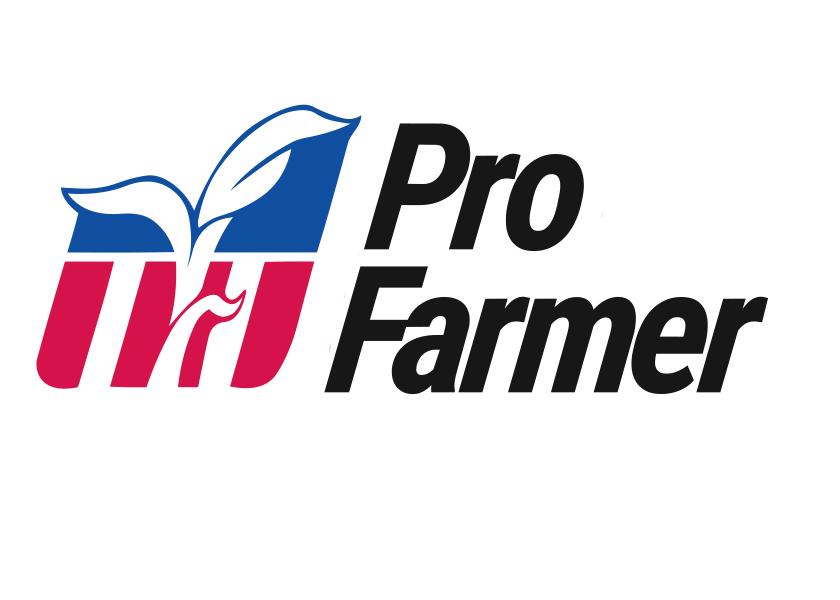PF Reaction: Bigger-than-expected corn, bean crops drive ending stocks higher than anticipated

Market reaction
Ahead of USDA's reports, corn futures were trading around 6 cents lower, soybeans were 12 to 13 cents lower, winter wheat futures were 1 to 4 cents lower, spring wheat futures were 3 to 4 cents higher and cotton futures were mostly 150 to 170 points lower.
In reaction to the reports, corn futures have extended losses to 9 cents, while soybeans have dropped roughly 25 cents lower. Winter wheat futures are 4 to 5 cents higher, while spring wheat is up 5 to 9 cents. Cotton futures are 120 to 140 points lower.
Crop production
Corn: 15.019 billion bu.; trade expected 14.973 billion bu.
— compares to 14.996 billion bu. projected in September
Beans: 4.448 billion bu.; trade expected 4.415 billion bu.
— compares to 4.374 billion bu. projected in September
Cotton: 18.004 million bales; trade expected 18.370 million bales
— compares to 18.509 million bales projected in September
USDA raised its corn crop estimate 23 million bu. from last month, whereas traders expected a 23-million-bu. decline. USDA raised the national average yield by 0.2 bu. to 176.5 bu. per acre, which would be just 0.1 bu. below the record in 2017. It left harvested acres unchanged at 85.085 million acres.
USDA noted the second highest ear count in the 10 objective yield states and estimates record corn yields in California, Idaho, Illinois, Indiana, Kentucky, Michigan, New York, North Carolina, Ohio, Oklahoma, Pennsylvania and South Carolina.
Corn yields are estimated higher than last month in Iowa (up 3 bu. to 201 bu.), Kansas (up 2 bu. to 140 bu.), Minnesota (up 4 bu. to 178 bu.) and Nebraska (up 2 bu. to 190 bu.). USDA left yields unchanged in South Dakota (133 bu.) and Wisconsin (172 bu.). USDA cut yields in Illinois (down 4 bu. to 210 bu.), Indiana (down 3 bu. to 194 bu.), Michigan (down 3 bu. to 171 bu.), Missouri (down 5 bu. to 164 bu.), North Dakota (down 1 bu. to 107 bu.) and Ohio (down 2 bu. to 188 bu.).
USDA raised its soybean crop estimate 74 million bu. from last month to a record level, which was 33 million bu. more than traders expected. It increased the national average soybean yield by 0.9 bu. to 51.5 bu. per acre, which would be the second highest on record behind 51.9 bu. in 2016. USDA left its harvested acreage estimate unchanged at 86.436 million acres.
USDA estimates record yields in Georgia, Illinois, Indiana, Iowa, Kentucky, Maryland, Mississippi, Nebraska, New York, Ohio, Pennsylvania and Virginia.
Soybean yields are estimated higher than last month in Iowa (up 2 bu. to 61 bu.), Kansas (up 2 bu. to 42 bu.), Minnesota (up 2 bu. to 49 bu.), Nebraska (up 2 bu. to 61 bu.), North Dakota (up 1 bu. to 26 bu.), South Dakota (up 2 bu. to 40 bu.) and Wisconsin (up 5 bu. to 54 bu.). USDA left yields unchanged in Arkansas (50 bu.), Illinois (64 bu.), Indiana (60 bu.), Michigan (50 bu.) and Ohio (58 bu.). USDA cut yields in Missouri (down 1 bu. to 50 bu.).
USDA cut its cotton crop estimate by 505,000 bales from last month, which was 366,000 bales more than traders expected. It cut the cotton yield by 24 lbs. to 871 lbs. per acre. USDA left the harvested acreage estimate unchanged at 9.922 million acres.
USDA cut the Texas cotton yield by 55 lbs. to 732 lbs. per acre.
U.S. carryover
Corn: 1.236 billion bu. for 2020-21; up from 1.187 billion bu. in September
— 1.500 billion bu. for 2021-22; up from 1.408 billion bu. in September
Beans: 256 million bu. for 2020-21; up from 175 million bu. in September
— 320 million bu. for 2021-22; up from 185 million bu. in September
Wheat: 580 million bu. for 2021-22; down from 615 million bu. in September
Cotton: 3.15 million bales for 2020-21; unchanged from 3.15 million bales in September
— 3.20 million bales for 2021-22; down from 3.70 million bales in September
To get to the Sept. 1 corn stocks tally of 1.236 billion bu. (2020-21 carryover), USDA dropped total old-crop supplies 72 million bu. (with the 2020 corn crop adjusted down). Old-crop feed & residual use is now put at 5.597 billion bu., down 128 million bu. from last month. Food, seed and industrial use is down 1 million bu. to 6.469 billion and exports were inched up 8 million bu. to 2.753 billion bushels. USDA puts the national average on-farm cash corn price for 2020-21 at $4.53 per bu., down 2 cents from last month.
Total corn supplies for 2021-22 are up 72 million bu. from last month with the 49-million-bu. increase in old-crop carry reflected in beginning stocks for 2021-22 and the corn crop estimate up 23 million bu. from September. On the demand-side of the balance sheet, new-crop corn feed and residual use is put at 5.650 billion bu. (down 50 million bu. from last month); food, seed and industrial use at 6.630 billion bu. (up 5 million bu. — corn-for-ethanol unchanged at 5.2 billion bu.); and exports at 2.5 billion bushels (up 25 million bu. from September). Corn carryover for 2021-22 is 68 million bushels above the average pre-report trade guess and is up 92 million bu. from last month. USDA puts the national average on-farm cash corn price at $5.45, unchanged from last month
To get to the Sept. 1 soybean stocks tally of 256 million bu., USDA increased total supplies 81 million bushels (with the 2020 bean crop adjusted up). Total demand was unchanged from last month at 4.505 billion bushels. Crush inched up 1 million bu. from last month to 2.141 billion bu. and soybean exports pushed up 5 million bu. to 2.265 billion bushels. Seed use was unchanged at 101 million bu., which means residual “use” was cut 7 million bu. to -3 million bushels. (A negative residual use means at least 3 million bushels will eventually be added to 2020-21 bean supplies.) USDA puts the 2020-21 national average on-farm cash bean price at $10.80, down a dime from last month.
Total soybean supplies for 2021-22 are up 145 million bu. from last month with beginning stocks up 81 million bu. (to 256 million bu.), production up 74 million bu. from last month and imports down 10 million bushels (to 15 million bu.). On the demand-side of the balance sheet, USDA now puts crush at 2.190 billion bu. (up 10 million bu. from last month) and exports at 2.090 billion bushels (unchanged from September). Soybean carryover for 2021-22 is 20 million bu. above the average trade guess and is up 135 million bu. from last month. USDA puts the national average on-farm cash bean price at $12.35, down 55 cents from last month.
Wheat carryover for 2021-22 is 4 million bu. above the average pre-report trade estimate, but is down 35 million bu. from last month. Total supplies for 2021-22 were cut 60 million bu. from last month, with beginning stocks up 1 million bu. (to 845 million bu.), production down 51 million bu. from September, and imports down 10 million bu. from last month (to 125 million bu.). On the demand-side of the balance sheet, USDA cut total use 25 million bushels (the entire cut comes out of the feed and residual category which is now put at 135 million bu.). USDA puts the 2021-22 national average on-farm cash wheat price at $6.70, up a dime from last month.
USDA made no change to the supply-side of the old-crop balance sheet for cotton. For 2020-21 demand, USDA increased total use 50,000 bales with all the increase in domestic use. Estimated exports were unchanged at 16.37 million bales. Unaccounted use was trimmed 50,000 bales to keep ending stocks at 3.15 million bales. The national average on-farm cash cotton price for 2020-21 is 66.3 cents, down 0.2 cent from last month.
On new-crop cotton, USDA cut total supplies by 500,000 bales, the result of steady beginning stocks, a cut to the cotton crop and a 10,000-bale increase in imports (to 10,000 bales). On the demand-side, USDA held domestic use at 2.5 million bales and exports at 15.5 million bales. There was also no change to unaccounted use, so the 500,000-bale cut to supplies pulled ending stocks down by that amount to 3.2 million bales. USDA puts the 2021-22 national average on-farm cash cotton price at 90 cents, up 6 cents from last month.
Global carryover
Corn: 289.99 MMT for 2020-21; up from 286.48 MMT in September
— 301.74 MMT for 2021-22; up from 297.63 MMT in September
Beans: 99.16 MMT for 2020-21; up from 95.08 MMT in September
— 104.57 MMT for 2021-22; up from 98.89 MMT in September
Wheat: 288.36 MMT for 2020-21; down from 292.56 MMT in September
— 277.18 MMT for 2021-22; down from 283.22 MMT in September
Cotton: 90.30 million bales for 2020-21; down from 91.30 million bales in September
— 87.13 million bales for 2021-22; up from 86.68 million bales in September
Global production highlights
Argentina beans: 46.2 MMT for 2020-21; compares with 46.0 MMT in September
— 51.0 MMT for 2021-22; compares with 52.0 MMT in September
Brazil beans: 137.0 MMT for 2020-21; compares with 137.0 MMT in September
— 144.0 MMT for 2021-22; compares with 144.0 MMT in September
Argentina wheat: 17.65 MMT for 2020-21; compares with 17.65 MMT in September
— 20.00 MMT for 2021-22; compares with 20.00 MMT in September
Australia wheat: 33.0 MMT for 2020-21; compares with 33.0 MMT in September
— 31.5 MMT for 2021-22; compares with 31.5 MMT in September
China wheat: 134.25 MMT for 2020-21; compares with 134.25 MMT in September
— 136.90 MMT for 2021-22; compares with 136.90 MMT in September
Canada wheat: 35.18 MMT for 2020-21; compares with 35.18 MMT in September
— 21.00 MMT for 2021-22; compares with 23.00 MMT in September
EU wheat: 126.00 MMT for 2020-21; compares with 125.94 MMT in September
— 139.40 MMT for 2021-22; compares with 139.00 MMT in September
Russia wheat: 85.35 MMT for 2020-21; compares with 85.35 MMT in September
— 72.50 MMT for 2021-22; compares with 72.50 MMT in September
Ukraine wheat: 25.42 MMT for 2020-21; compares with 25.42 MMT in September
— 33.00 MMT for 2021-22; compares with 33.00 MMT in September
China corn: 260.67 MMT for 2020-21; compares with 260.67 MMT in September
— 273.00 MMT for 2021-22; compares with 273.00 MMT in September
Argentina corn: 50.0 MMT for 2020-21; compares with 50.0 MMT in September
— 53.0 MMT for 2021-22; compares with 53.0 MMT in September
Brazil corn: 86.0 MMT for 2020-21; compares with 86.0 MMT in September
— 118.0 MMT for 2021-22; compares with 118.0 MMT in September
Ukraine corn: 30.3 MMT for 2020-21; compares with 30.3 MMT in September
— 38.0 MMT for 2021-22; compares with 39.0 MMT in September
South Africa corn: 16.9 MMT for 2020-21; compares with 17.0 MMT in September
— 17.0 MMT for 2021-22; compares with 17.0 MMT in September
China cotton: 29.50 million bales for 2020-21; compares with 29.50 million bales in September
— 26.75 million bales for 2021-22; compares with 26.75 million bales in September






